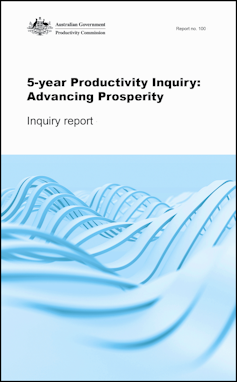Source: The Conversation (Au and NZ) – By Stephen King, Professor, Monash University

Shutterstock
Australia is a living testament to the benefits of productivity growth.
An average worker today puts in 14 fewer hours per week and takes home a real wage six times that of the average worker in 1901 – all because we are producing more per hour worked.
And yet in the past decade that rate of improvement has slowed.
Over the 60 years to 2019-20, labour productivity (production per hour worked) grew at an average of 1.8% per year, which sounds small but compounds each year.
In the most recent of those decades, the decade to 2020, growth fell to just 1.1% – a drop of one-third.
If it remains that low we will be much worse off in decades to come than we would be if we could get back to the kind of growth we had.

Productivity Commission
That’s one of the reasons I was excited to work on the Productivity Commission’s second five-yearly productivity report, released today by Treasurer Jim Chalmers.
Victims of our own success
In some ways, Australia has been a victim of its success. It has a robust and highly productive economy, especially in mining and agriculture where it is among the world’s leaders.
But, as productivity growth in mining and agriculture has made us wealthier, we have demanded more services, such as holidays, housecleaning, childcare and after-school care, gyms and home-delivered food.
Now employing 90% of our workers and accounting for 80% of our economy, services are harder to make more productive, and as our population ages they are likely to account for an even greater share of what we do.
In government-funded non-market services such as health, education and public administration, measured labour productivity growth has been close to zero since the turn of the century.
If we want to continue to improve our standard of living, we are going to have to tackle productivity in services as well as in goods, including in human services that are usually provided off market by the government.
How to improve
Our report tackles the problem over nine volumes and 964 pages, coming up with 29 “reform directives” and 71 specific recommendations.
It focuses on five key themes:
-
building a skilled and adaptable workforce
-
harnessing data and digital technology and diffusing new ideas
-
creating a more dynamic economy
-
lifting productivity in the non-market sector
-
securing net zero carbon emissions at least cost
I’ll give you a taste of our recommendations across three of these themes.
The uptake of telehealth and video conferencing during the pandemic shows how technology can improve productivity and increase access to services. We will need to better leverage these digital technologies, particularly in non-market services such as education and public administration.

Shutterstock
Digital services need a strong and ubiquitous internet, covering all of the population, including the population in regional Australia. But Infrastructure Australia has found 23 of the 48 regions in Australia have broadband and mobile connectivity gaps.
In health, better connections can save lives. We need to fill the gaps using the mix of technology that will best allow all Australians to benefit from the digital connectivity revolution.
Data is also crucial. We need better linking of data to improve government-funded services and better rules around cybersecurity to protect that data.
Focus on outcomes rather than inputs
Too often, government funding rules for health, education, public housing and other services focus on inputs (the funding delivered) rather than outcomes (the service delivered).
These rules limit innovations in service delivery that would boost productivity and benefit consumers. The rules need to be more flexible to allow increased innovation, working out what works and spreading best practice to all providers, while ensuring consumer safety.
A more productive economy will increasingly need a more adaptable and better-trained workforce. Most of the new jobs created in the next five years will require tertiary qualifications, particularly university qualifications.
To meet this demand we will need to both better “educate our own” and target our migration system to fill skills gaps.
A road map for reform
This is the Productivity Commission’s second five-yearly productivity report.
The first made explicit that productivity was not about extracting more sweat from the brow of an already hard-working Australian, but was instead about
-
promoting better investment in workplaces
-
supporting the research and trialling of new ideas
-
removing outmoded regulations that prevent consumers and businesses obtaining better services
This report builds on the first to provide a road map, focusing first on the high-impact low-cost reforms. Some are quick and others will take time and planning.
All will face opposition. Vested interests benefit by exploiting economic inefficiencies for their own gain. Without reform, we will all be poorer.
Read more:
Memo Productivity Commission: fixing inequality will boost productivity
![]()
Stephen King is a Commissioner with the Productivity Commission
– ref. I helped write the Productivity Commission’s 5-year productivity review: here’s what I think Australia should do – https://theconversation.com/i-helped-write-the-productivity-commissions-5-year-productivity-review-heres-what-i-think-australia-should-do-201378






